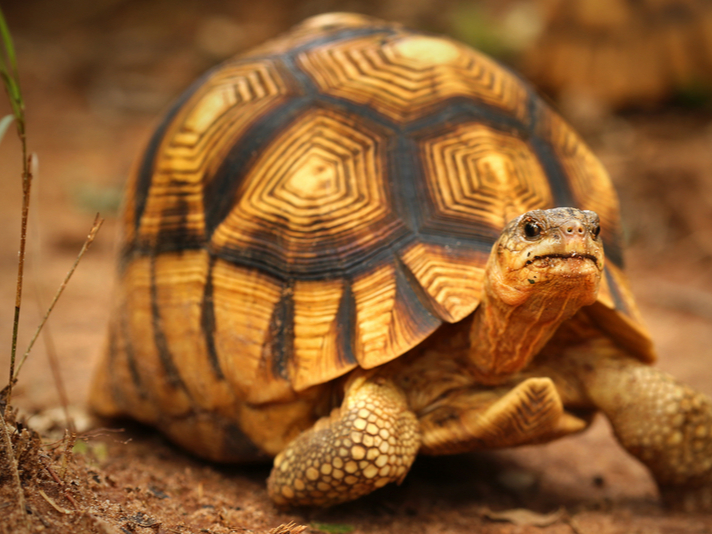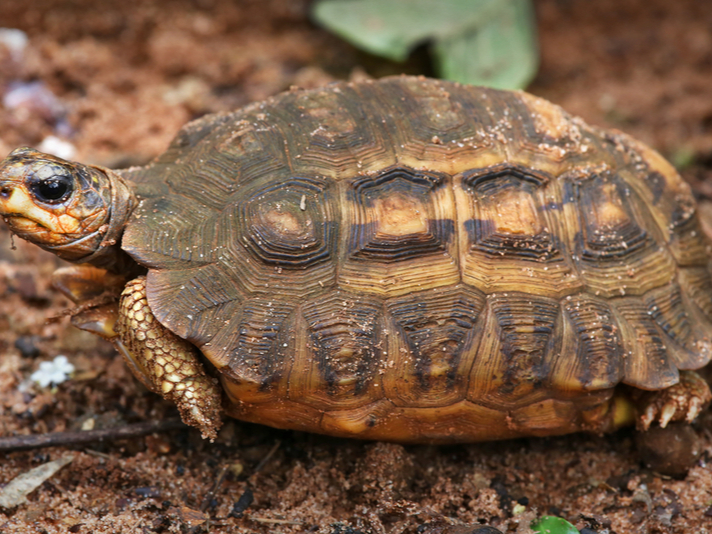Experts believe the ploughshare tortoise will become extinct within the next 40 to 50 years.
The ploughshare tortoise (Astrochelys yniphora), endemic to Madagascar, shares the 11th spot with the flat-tailed and spider tortoises on ZSL's EDGE List Of Endangered Reptiles.

Ryan M. Bolton/Shutterstock
Experts believe the ploughshare tortoise will become extinct within the next 40 to 50 years.
The ploughshare tortoise, also called the Angonoka tortoise, has suffered due to hunting and the clearing of its habitat by fire in its native Madagascar. It is estimated that there are less than 1,000 ploughshare tortoises left in the wild, and of those, just 200 are of breeding age. Large numbers of these tortoises have been confiscated by authorities, including a seizure in 2013 of 54 individuals in Thailand.
Given the continued threats to this species, experts believe it will become extinct in the next 40 to 50 years, according to the EDGE List Of Endangered Reptiles. The ploughshare tortoise is listed as critically endangered by the IUCN and its Conservation Attention is listed as good.
Zoological Society of London Releases EDGE Reptiles List Of Endangered Species
The flat-tailed spider tortoise (Pyxis planicauda) is also native to Madagascar and occupies an area of less than 500 square kilometers. The species has a flat tail and despite doing poorly in captivity, is in high demand in the international pet trade. It has lost more than 70 percent of its habitat in three generations, which has led to a population decline of 60 percent with an expected further loss of 30 percent.

Ryan M. Bolton/Shutterstock
The flat-tailed spider tortoise (Pyxis planicauda) is also native to Madagascar and occupies an area of less than 500 square kilometers.
This reptile has apparently benefited from being listed as an Appendix I animal as the legsl trade of the species has apparently stopped and its population in the wild stabilized. It is pprotected in Madagascar and is known to exist in three known locations. It is also being captive bred to bolster its populations. The flat-tailed spider tortoise is listed as critically endangered by the IUCN and its Conservation Attention is listed as Medium.
The spider tortoise (Pyxis arachnoides) is also endemic to Madagascar, and its populations have been negatively affected by habitat loss and collection for the international pet trade as well as for food consumption. Its livers are exported to Asia.

Reptiles4all/Shutterstock
The spider tortoise has lost an estimated 40 percent of its habitat and is nationally protected.
It, along with the flat-tailed spider tortoise, is one of two species of the genus Pyxis. The spider tortoise has lost an estimated 40 percent of its habitat and is nationally protected and is listed on the CITES Appendix I list of endangered reptiles. It occurs in just two locations in Madagascar, though conservation breeding efforts continue. Its Conservation Attention is listed as Medium.



